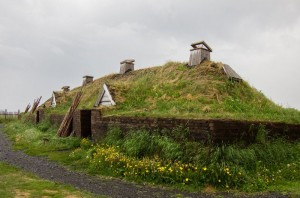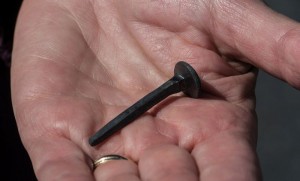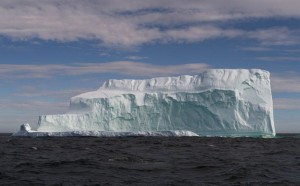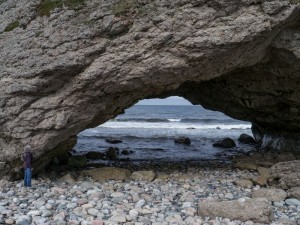 As part of my research for a historical novel about Gudrid Thorbjarnardottir, we went in search of one of the places she traveled to in the early 1,000s. It was more than intriguing.
As part of my research for a historical novel about Gudrid Thorbjarnardottir, we went in search of one of the places she traveled to in the early 1,000s. It was more than intriguing.
Leif Eiriksson discovered something big around 1,000 A.D. You can still see the footprints of his longhouses at L’Anse aux Meadows on the northern tip of Newfoundland, Canada. He and his men are thought to be the first Europeans to build in North America.
But scholars argue about exactly where his VÃnland is, which is puzzling. Maybe they don’t have a GPS?
 His sod longhouse at Leifsbudir, which means Leif’s booths (tents) – his ironic name for these buildings with six foot thick walls – was at least twice the size of his father’s house in Greenland. You know his father… Eirik the Red, pioneer of Greenland. Leif obviously inherited his father’s place-naming humor. Gudrid, the m.c. of my YA novel, was Leif’s sister-in-law and went to Leifsbudir a couple of years after he did. It is easy to imagine her there. The small spindle whorl found by archeologists might actually have been hers.
His sod longhouse at Leifsbudir, which means Leif’s booths (tents) – his ironic name for these buildings with six foot thick walls – was at least twice the size of his father’s house in Greenland. You know his father… Eirik the Red, pioneer of Greenland. Leif obviously inherited his father’s place-naming humor. Gudrid, the m.c. of my YA novel, was Leif’s sister-in-law and went to Leifsbudir a couple of years after he did. It is easy to imagine her there. The small spindle whorl found by archeologists might actually have been hers.
The nearby peat bog provided the blocks of sod stacked over a framework of timber from the nearby forest, which is the same form of construction in Iceland and Greenland at the time. Clayton Colbourne, who grew up in the contemporary village of L’Anse aux Meadows and as a kid played on what were thought to be Indian mounds until archeologists arrived, helped build the reconstructions. It was laborious.
Inside, Egill Egilsson (aka Wade Hillier) played a lyre based on one from a VÃking site in Sutton Hoo, then a flute with a single hole that elicited a lovely, lively melody, and lastly a small whistle made from a pig or sheep bone. He also had a wooden panpipe for use in a pinch. A local woman meanwhile did some mending by the longfire on one of the sleeping benches that lined the two long walls.
The blacksmith whose shop is next door showed the type of iron ore that the Norse dug from the nearby bog and a bar of smelted iron, a piece of which he then forged into a nail.  In true Viking fashion, he did not bother with gloves while working the metal. Perhaps the Norse uncovered the ore while cutting the peat blocks they used for construction? The process of smelting the small, surprisingly lightweight, lumps of ore into useable iron involves felling lots of trees to make the charcoal that was used for firing up the forge. The paired bellows keep the temperature high enough that the blacksmith can work the purified iron into a nail or other item. Leif’s men made 100-200 nails in this way to repair an accident with one of their boats.
In true Viking fashion, he did not bother with gloves while working the metal. Perhaps the Norse uncovered the ore while cutting the peat blocks they used for construction? The process of smelting the small, surprisingly lightweight, lumps of ore into useable iron involves felling lots of trees to make the charcoal that was used for firing up the forge. The paired bellows keep the temperature high enough that the blacksmith can work the purified iron into a nail or other item. Leif’s men made 100-200 nails in this way to repair an accident with one of their boats.
The views the Norse saw surrounding Leifsbudir are reminiscent of places in Iceland and Greenland, only better. There is plenty of fog, rain and high winds at times, and yes there are icebergs; this one is 175 feet tall by 600 feet long and grounded in 420 feet of water. But there was longer daylight and warmer temperatures in winter, and millions of flowers – irises, harebells, pitcher plants, baked apple (cloudberries), partridgeberries and some cotton grass. Dense forests called tuckamore grew near the shore and more mixed deciduous and evergreens further inland. Trees were and are valuable commodities. A family of gorgeously golden-red foxes lives on the stony ridge just over the encampment. Life here is difficult, but good.
600 feet long and grounded in 420 feet of water. But there was longer daylight and warmer temperatures in winter, and millions of flowers – irises, harebells, pitcher plants, baked apple (cloudberries), partridgeberries and some cotton grass. Dense forests called tuckamore grew near the shore and more mixed deciduous and evergreens further inland. Trees were and are valuable commodities. A family of gorgeously golden-red foxes lives on the stony ridge just over the encampment. Life here is difficult, but good.
Within a few days’ sail in a knörr – or in a car like ours – are some unusual phenomena Leif, Gudrid and their people would have found intriguing. Close-by at Burnt Cape there is a harsh shale covered plateau with miniscule flora and scrawny trees growing flat, horizontally espaliered by the wind. There too are frost polygons, where extreme temperature cycles have configured the shale-like stone into rings or polygons with bigger stone on the outside and small shards within, like the footprints of some dragon. Further south at Port au Choix are limestone cliffs studded with spiral fossils. South of that is a stone formation at tideline with three big arches worn into the rock whose cobble beach is paved with every imaginable pattern and color. And at Cow Head is Shallow Bay’s fine sand beach and calm water glowing at sunset, embraced within the arms of two headlands.
with three big arches worn into the rock whose cobble beach is paved with every imaginable pattern and color. And at Cow Head is Shallow Bay’s fine sand beach and calm water glowing at sunset, embraced within the arms of two headlands.
No moose in 1000 AD, but now they average four per square kilometer. We saw eight without trying. Frequent woodpiles and small vegetable gardens seemingly in the middle of nowhere along roadsides are contemporary, though the struggle for heat through the seven month winters and for food are timeless. Those living on “The Rock†are resourceful and self-sufficient like Leif, Gudrid, and their compatriots were.
photos and videos by Egils Zarins







2 Comments